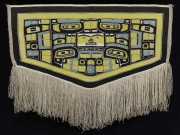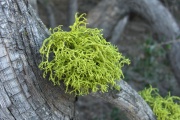Difference between revisions of "Vulpinic acid"
Jump to navigation
Jump to search
| Line 11: | Line 11: | ||
== Other Properties == | == Other Properties == | ||
| − | Vulpinic acid is toxic by ingestion. | + | Vulpinic acid is toxic by ingestion and may be absorbed through the skin. |
Revision as of 13:17, 2 May 2018
Description
A natural yellow dye extracted from wolf lichen (Letharia vulpina). Vulpinic acid (C19H14O5) is a methyl ester derivative of pulvinic acid that was first isolated in 1925. The bright yellow dye has been used by Northwest Coast First Peoples for dyeing porcupine quills and wool. It was identified by MALDI-TOF mass spectrometry in yellow wool in the MFA's Chilkat Dancing Blanket (#2008.650)
Synonyms and Related Terms
Letharia vulpinia
Other Properties
Vulpinic acid is toxic by ingestion and may be absorbed through the skin.
| Composition | C19H14O5 |
|---|---|
| CAS | 521-52-8 |
| Molecular Weight | mol. wt. = 322.32 g·mol−1 |
Sources Checked for Data in Record
- George Thornton Emmons, The Tlingit Indians, Anthropological Papers of the American Museum of Natural History, 1991.
- Leonard Soltzberg, internal report

